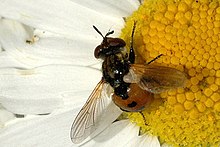Gymnosoma
Appearance
| Gymnosoma | |
|---|---|

| |
| Gymnosoma nudifrons male | |
| Scientific classification | |
| Kingdom: | |
| Phylum: | |
| Class: | |
| Order: | |
| Family: | |
| Subfamily: | |
| Tribe: | |
| Genus: | Gymnosoma Meigen, 1803
|
| Type species | |
| Musca rotundata | |
| Synonyms[1] | |
| |
Gymnosoma is a genus of flies in the family Tachinidae.[2]
The name "Gymnosoma" literally translates as "naked body",[3] and presumably refers to the fact that some species in the genus are less conspicuously bristly than most species of flies in the family Tachinidae.
Species
- G. acrosterni Kugler, 1971[2]
- G. amplifrons (Brooks, 1946)[1]
- G. brachypeltae Dupuis, 1961[2]
- G. brevicorne Villeneuve, 1929
- G. canadense (Brooks, 1946)[1]
- G. carpocoridis Dupuis, 1961[2]
- G. clavatum (Rohdendorf, 1947)[2]
- G. costatum (Panzer, 1800)[2]
- G. desertorum (Rohdendorf, 1947)[2]
- G. dolycoridis Dupuis, 1961[2]
- G. filiola Loew, 1872[1]
- G. fuliginosum Robineau-Desvoidy, 1830[1]
- G. hamiense Dupuis, 1966[4]
- G. indicum Walker, 1853[4]
- G. inornatum Zimin, 1966[2]
- G. maxima
- G. nitens Meigen, 1824[2][5][6][7]
- G. nudifrons Herting, 1966[2]
- G. occidentale Curran, 1927[1]
- G. par Walker, 1849[1]
- G. philippinense (Townsend, 1928)
- G. rotundatum (Linnaeus, 1758)[2][5][6][7]
- G. rungsi (Mesnil, 1952)[2]
- G. siculum Dupuis & Genduso, 1981[2]
References
- ^ a b c d e f g O'Hara, James E.; Wood, D. Monty (28 January 2004). "Checklist Of The Tachinidae (Diptera) Of America North Of Mexico" (PDF). Nicaragua: Biodiversidad de Nicaragua. pp. 1–42.
- ^ a b c d e f g h i j k l m n "Fauna Europaea version 2.4". European Commission. 27 January 2011. Retrieved 12 March 2011.
- ^ Jaeger, Edmund C. (1959). A source-book of biological names and terms. Springfield, Ill: Thomas. ISBN 0-398-06179-3.
- ^ a b Mitra, Bulganin; Sharma, R.M. "Checklist Of Indian Tachinid Flies (Insecta: Diptera: Tachinidae)" (PDF). Jabalpur. pp. 1–18. Archived from the original (PDF) on 2010-12-17.
- ^ a b Chandler, Peter J. (1998). Checklists of Insects of the British Isles (New Series) Part 1: Diptera. New Series. Vol. 12. London: Royal Entomological Society of London. pp. 1–234. ISBN 0-901546-82-8.
{{cite book}}:|journal=ignored (help) - ^ a b Belshaw, Robert (1993). "Tachinid Flies Diptera Tachinidae". Royal Entomological Society Handbooks. 10 (4ai). Royal Entomological Society of London: 170.
- ^ a b van Emden, F.I. (1954). "Ditera Cyclorrhapha Calyptrata (I) Section (a) Tachinidae & Calliphoridae". Royal Entomological Society Handbooks. 10 (4a). Royal Entomological Society of London: 133.
